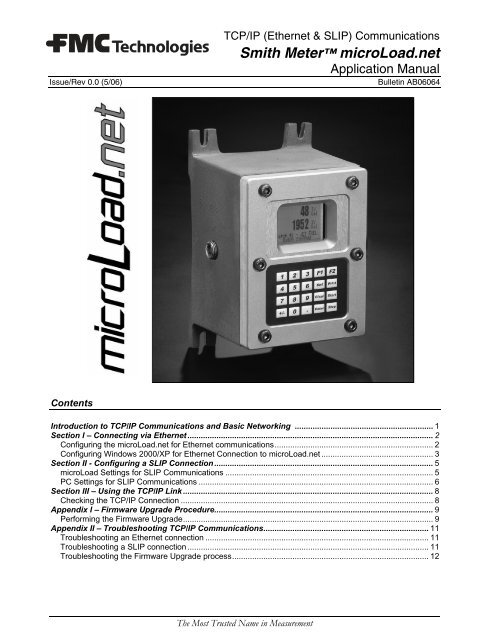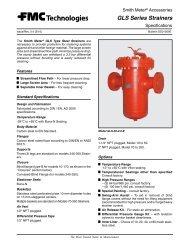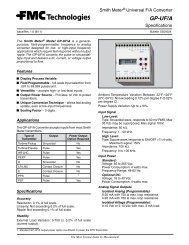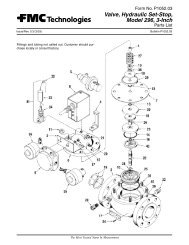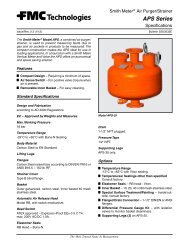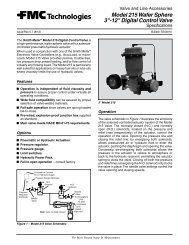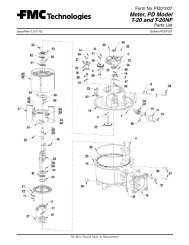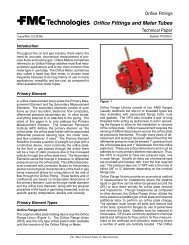AB06064 - Measurement Solutions - FMC Technologies
AB06064 - Measurement Solutions - FMC Technologies
AB06064 - Measurement Solutions - FMC Technologies
You also want an ePaper? Increase the reach of your titles
YUMPU automatically turns print PDFs into web optimized ePapers that Google loves.
Issue/Rev 0.0 (5/06)<br />
TCP/IP (Ethernet & SLIP) Communications<br />
Smith Meter microLoad.net<br />
Application Manual<br />
Bulletin <strong>AB06064</strong><br />
Contents<br />
Introduction to TCP/IP Communications and Basic Networking .............................................................. 1<br />
Section I – Connecting via Ethernet .............................................................................................................. 2<br />
Configuring the microLoad.net for Ethernet communications.......................................................................2<br />
Configuring Windows 2000/XP for Ethernet Connection to microLoad.net .................................................. 3<br />
Section II - Configuring a SLIP Connection.................................................................................................. 5<br />
microLoad Settings for SLIP Communications ............................................................................................. 5<br />
PC Settings for SLIP Communications ......................................................................................................... 6<br />
Section III – Using the TCP/IP Link ................................................................................................................ 8<br />
Checking the TCP/IP Connection ................................................................................................................. 8<br />
Appendix I – Firmware Upgrade Procedure.................................................................................................. 9<br />
Performing the Firmware Upgrade................................................................................................................ 9<br />
Appendix II – Troubleshooting TCP/IP Communications.......................................................................... 11<br />
Troubleshooting an Ethernet connection .................................................................................................... 11<br />
Troubleshooting a SLIP connection ............................................................................................................ 11<br />
Troubleshooting the Firmware Upgrade process........................................................................................ 12<br />
The Most Trusted Name in <strong>Measurement</strong>
Caution<br />
The default or operating values used in this manual and in the program of the<br />
microLoad.net are for factory testing only and should not be construed as default or<br />
operating values for your metering system. Each metering system is unique and each<br />
program parameter must be reviewed and programmed for that specific metering system<br />
application.<br />
Disclaimer<br />
<strong>FMC</strong> <strong>Technologies</strong> <strong>Measurement</strong> <strong>Solutions</strong>, Inc. hereby disclaims any and all<br />
responsibility for damages, including but not limited to consequential damages, arising out<br />
of or related to the inputting of incorrect or improper program or default values entered in<br />
connection with the Smith Meter TM microLoad.net.<br />
Proprietary Notice<br />
This document contains information that is proprietary to <strong>FMC</strong> <strong>Technologies</strong> <strong>Measurement</strong><br />
<strong>Solutions</strong>, Inc. and is available solely for customer information. The information herein<br />
shall not be duplicated, used, or disclosed without prior permission of <strong>FMC</strong> <strong>Measurement</strong><br />
<strong>Solutions</strong>.<br />
<strong>FMC</strong> <strong>Technologies</strong> <strong>Measurement</strong> <strong>Solutions</strong>, Inc. will not be held responsible for loss of<br />
liquid or for damage of any kind or from any cause to the person or property of others, or<br />
for loss or profit, or loss of use, or any other special, incidental, or consequential damages<br />
caused by the use or misapplication of the contents stated herein.<br />
i
Introduction – TCP/IP and Networking with microLoad.net<br />
Introduction to TCP/IP Communications and Basic Networking<br />
It is not necessary to become a skilled network administrator to successfully communicate with the<br />
microLoad.net via TCP/IP. However, some basic networking knowledge will be quite helpful in<br />
establishing and maintaining reliable communications with devices such as the microLoad.net that can be<br />
connected via Ethernet and TCP/IP. Some of the following terms may be encountered while configuring<br />
or maintaining your device connections:<br />
TCP/IP (Transfer Control Protocol/Internet Protocol) is the widely accepted standard protocol for<br />
Internet and World Wide Web communications. Many other Internet standard protocols – HTTP<br />
for Web browsing, FTP for file transfers, etc. – use TCP/IP as the underlying control protocol.<br />
Ethernet: A low-level protocol that implements the hardware link between two or more host<br />
devices. TCP/IP is often used over an Ethernet connection.<br />
MAC Address: A fixed, permanent 6-byte hardware address assigned to an Ethernet device by<br />
the manufacturer.<br />
IP Address: a four-byte (32 bit) number, usually displayed as 4 separate octets (8 bit numbers)<br />
i.e. 192.168.0.1, that uniquely identifies a host and network.<br />
IP address ranges are grouped by class; the first few bits determine the class. Class ‘A’ networks<br />
have a value from 0-127 in the first octet; class ‘B’ networks start with 128-191; class ‘C’ from<br />
192-223. The special values of 224-239 are reserved for class ‘D’ (multicast) addresses, and the<br />
values 244-255 are reserved (class ‘E’) addresses.<br />
Net Mask: The number of bits in the IP address that is used to specify the network address. The<br />
remaining bits specify the host address. A Class ‘C’ network has a net mask of 24 (the first 24<br />
bits are common to all machines on the network, the last 8 bits are the host id and are unique for<br />
each machine on the network). Therefore, a class ‘C’ network can have up to 254 hosts (host<br />
numbers 0 and 255 are reserved by the standard for special features such as broadcasting.) A<br />
very large class ‘A’ network has an 8 bit net mask – leaving 24 bits to specify the host. Hence this<br />
type of network can have a huge number of host machines -2 24 = over 16 million computers – but<br />
there can only be 255 of those types of networks in existence since there are only 255 unique<br />
network IDs that can be made from 8 bits. So why specify a net mask if it’s implied by the<br />
network class? The reason for a net mask is clear when it is realized that some networks need to<br />
have many more hosts than 255, and that there would not be very many networks if we only<br />
allowed Class ‘A’ networks. Net masks are often written out in octet form… 255.255.255.0 is the<br />
same as saying the net mask is 24 bits. It can also be specified with the network address using a<br />
backslash, i.e. 192.168.0.0/24. So, if we have a machine on that network with the IP address<br />
192.168.0.23 (A class ‘C’ network), the network address is 192.168.0 and the host address is 23.<br />
There are some network addresses that are reserved by the standard as ‘local network’<br />
addresses. These network addresses are allowed only behind a router that ‘hides’ the local<br />
network from the Internet. Many internal internet networks use these addresses: all the class ‘C’<br />
networks starting with 192.168.xxx.xxx/24 and the class ‘A’ network 10.xxx.xxx.xxx/8. Since most<br />
organizations do not require a full class ‘A’ network, often a subsection of the address space is<br />
used, i.e. 10.0.xxx..xxx/16. This is called ‘sub-netting’. Alternatively, sometimes two or more class<br />
‘C’ networks are combined thus: 192.168.0.xxx/23. This is known as ‘super-netting’.<br />
Gateway: a gateway address specifies where outgoing messages addressed to other networks<br />
should be directed. This allows devices like routers, hubs and switches to be specified as the<br />
interface to anything external to the physical network.<br />
There is much information on TCP/IP and networking on the World Wide Web. One such example of a<br />
more detailed description can be found at the time of this writing at http://www.faqs.org/rfcs/rfc1180.html.<br />
This is one of an entire series of RFCs (Request For Comments) that make up the documentation on<br />
networking standards.<br />
<strong>AB06064</strong> · Issue/Rev. 0.0 (5/06) Page 1
Section I – Connecting via Ethernet<br />
Configuring the microLoad.net for Ethernet Communications<br />
Power up the microLoad (wait for microLoad to complete initialization)<br />
Press at the Ready screen to access the Main Menu<br />
From the Main Menu, select Program Mode Menu and press <br />
Enter the Access Code when prompted and press <br />
From the Program Mode menu, select Comm. Directory and Press <br />
Select Host Interface and press <br />
From the Host Interface Menu set the following items:<br />
IP Address: 192.168.0.1<br />
Net mask: 255.255.255.0<br />
Gateway: 192.168.0.10<br />
Ethernet Control: Poll and Program<br />
Com Link: Level 3<br />
Return to the Main Menu using the key<br />
Note: If using the microLoad.net’s Ethernet port, make sure that none of the microLoad.net serial<br />
communications ports are configured to the ‘SLIP (TCP/IP)’ function – configuring a SLIP connection will<br />
disable the Ethernet connection.<br />
It is recommended that the microLoad.net be installed to a private network (not connected directly to the<br />
rest of the corporate LAN). This is best implemented by adding a second network interface card to the PC<br />
that will be interfaced to the microLoads. This dual-interface PC can be set up as a ‘bridge’ allowing all<br />
the other PCs in the corporate environment to reach the microLoad devices (given permission to do so)<br />
but will prevent all other corporate LAN traffic from interfering with the microLoad.net communications.<br />
Page 2 <strong>AB06064</strong> · Issue/Rev. 0.0 (5/06)
Section I – Connecting via Ethernet<br />
Configuring Windows 2000/XP for Ethernet Connection to microLoad.net<br />
Requirements:<br />
A Network Interface Card (NIC) installed in the PC and either:<br />
o a CAT-5 ‘crossover’ cable;<br />
or alternately<br />
o two regular CAT-5 cables, and an Ethernet hub/switch/router such as those<br />
manufactured by D-Link, LINKSYS, 3Com, et. al.<br />
Your PC has a NIC interface if there is an Ethernet port (CAT-5 connector) present on the back of the<br />
computer. Most modern PCs have the Ethernet hardware integrated on the motherboard. Typically these<br />
ports are labeled with a network icon: If there is no Ethernet hardware in your PC you can add one –<br />
they are relatively inexpensive and easy to install. Another option is to use a SLIP connection (see the<br />
section later in the manual on SLIP).<br />
There are two ways to connect the microLoad to your PC using Ethernet – either machine-to-machine,<br />
using a crossover cable; or connecting both the PC and the microLoad to a multi-port network device<br />
such as a hub, switch or router.<br />
If using a crossover cable, plug one end of the cable into the Ethernet port on the PC. If using a hub,<br />
connect the PC’s Ethernet port to one of the router’s ports using a standard cable.<br />
At the microLoad.net, remove the cover and find the CAT-5 connector (CN8) on the back of the MNET<br />
board (the main board, attached to the cover). Plug the other end of the crossover cable in here, or if<br />
using a hub connect the second standard CAT-5 cable between the microLoad.net and another port on<br />
the hub. The microLoad has two LEDs near CN8 – the green LED will light if the physical connection is<br />
established properly. The yellow LED will blink when traffic appears on the network.<br />
Note: If the system is currently on a network, be sure to record all values prior to changing the connection<br />
settings so the network connection can be restored to the original state.<br />
Configuring the PC’s settings for Ethernet communications with the microLoad.net:<br />
Click on Start Menu > Settings > Network Connections > Local Area Connection<br />
<strong>AB06064</strong> · Issue/Rev. 0.0 (5/06) Page 3
Section I – Connecting via Ethernet<br />
►<br />
Uncheck all of the boxes EXCEPT the check box for “Internet Protocol (TCP/IP)”<br />
Make sure that the “Internet Protocol (TCP/IP)” line is selected then click ‘Properties’<br />
Select “Use the following IP address”<br />
Enter an IP address on the same network as the microLoad, i.e. 192.168.0.10<br />
(Make sure the host address is different than the microLoad.net!)<br />
Enter the subnet mask: 255.255.255.0<br />
Click OKAY when finished<br />
Click OKAY again to exit the Local Area Connection dialog<br />
Continue with the section titled Establishing and Verifying a Successful Connection<br />
Page 4 <strong>AB06064</strong> · Issue/Rev. 0.0 (5/06)
Section II – Configuring a SLIP Connection<br />
Configuring SLIP Communications (Available with Windows 2000/XP Only)<br />
If an Ethernet connection is not available or distances prevent the use of Ethernet, the microLoad.net can<br />
also support TCP/IP communications over one of the serial ports. This is implemented via SLIP (Serial<br />
Line Internet Protocol) support in the microLoad.net.<br />
Note: Skip this section if using Ethernet. Continue with the section titled Establishing and Verifying a<br />
Successful Connection<br />
Remove cover and connect the microLoad communications port to the PC serial port using a serial<br />
communications line. (microLoad.net Comm 1 is used in the example.) Wire the serial connection as for<br />
any other serial protocol. (For instructions on connecting the microLoad to the PC via serial<br />
communications please refer to the installation manual for the microLoad.)<br />
microLoad.net Settings for SLIP Communications<br />
Power up the microLoad.net (wait for microLoad to go through its initialization period ie. RAM and<br />
ROM test)<br />
Press from the ready screen to access the Main Menu<br />
Once in the Main Menu screen, select Program Mode Menu and press <br />
Enter the access code when prompted and press <br />
Select Comm. Directory and Press from the Program Mode Menu<br />
From Comm. Directory select the Comm. Port Config and press <br />
Select Comm. 1 and press <br />
From Comm. 1 Directory, select the following items and set as indicated below:<br />
Function: SLIP (TCP/IP)<br />
Baud: 38,400<br />
Data Parity: 8/None<br />
Timeout: 0<br />
Mode: RS232<br />
After ALL items from above are set, press twice to return to the Communications<br />
Directory Menu<br />
Select Host Interface and press <br />
From the Host Interface Menu set the following Items as indicated below:<br />
IP Address: 192.168.0.1<br />
Network:255.255.255.0<br />
Gateway: 192.168.0.1<br />
Ethernet Control: Poll and Program<br />
Com Link: Level 1<br />
Note: SLIP is a point to point protocol and is not intended for multi-dropped serial networks. It is possible<br />
to utilize a SLIP connection in a multi-drop environment for special features such as firmware upgrades,<br />
but any additional microLoad.net devices on the communications line must have the serial port<br />
functionality disabled before attempting to connect to any one unit.<br />
<strong>AB06064</strong> · Issue/Rev. 0.0 (5/06) Page 5
Section II – Configuring a SLIP Connection<br />
PC Settings for SLIP Communications<br />
Click on Start > Settings > Network Connections > New Connection Wizard:<br />
In the New Connection Wizard, perform the following steps:<br />
o Select on the “Welcome to the New Connection Wizard” page)<br />
o Select “Set up an Advanced Connection”, from the list then click <br />
o Select “Connect directly with another computer”, then click <br />
o Select “Guest”, then click <br />
o In the text box, type in “microLoad via SLIP” or something identifiably unique<br />
o Select “Communications cable between two computers (Com 1)” when the wizard<br />
prompts for a device selected. Click <br />
o Click on “Anyone’s Use” for connection availability. Click <br />
o Click on the Confirmation page of the Wizard<br />
Upon completion, a new screen will pop up automatically with the title “Connect to microLoad via<br />
SLIP”<br />
Click <br />
o In the General tab, select “Communications cable between two computers (COM n)”.<br />
Verify the selection corresponds to the desired port.<br />
o Click on the button located on the same screen (below the selected device).<br />
Set the baud rate to 38400. In the hardware features verify that all boxes are unchecked.<br />
Click to return to the Properties dialog.<br />
►<br />
Page 6 <strong>AB06064</strong> · Issue/Rev. 0.0 (5/06)
Section II – Configuring a SLIP Connection<br />
Click on the Options tab. Un-check the “Prompt for name<br />
and password, etc.” box. The other options can be left the<br />
same.<br />
Click on the Networking tab.<br />
o From the drop down menu for the type of dial<br />
up server I am calling, select “SLIP: UNIX<br />
Connection”<br />
o Clear all checkboxes except for Internet<br />
Protocol (TCP/IP) and QoS Packet<br />
Scheduler.<br />
o Select “Internet Protocol (TCP/IP) ” in the list<br />
box and click <br />
A new window will appear that is labeled “Internet<br />
Protocol (TCP/IP) Properties”<br />
o Select “Use the following IP address”<br />
o Specify an address that is DIFFERENT<br />
from but on the same subnet as the<br />
microLoad you are using<br />
For example, if the microLoad is configured<br />
for 192.168.0.1, set the PC to 192.168.0.5, or<br />
192.168.0.10, etc.<br />
Click to exit the dialog then click at the bottom of the microLoad SLIP Connection Properties<br />
window. If all is configured correctly, the dialog should report ‘connected’ and the link will be established<br />
successfully.<br />
<strong>AB06064</strong> · Issue/Rev. 0.0 (5/06) Page 7
Section III – Using the TCP/IP Link<br />
Using the TCP/IP Link<br />
Checking the TCP/IP Connection<br />
Install the latest version of the microMate software. This can be found on the World Wide Web – go<br />
to http://www.microLoad.net. It is recommended that the installation defaults be used, resulting in the<br />
program being installed to the directory C:\Program Files\Smith Meter\microMate for microLoad.net.<br />
After installation, perform the following steps to check the connection you established:<br />
Launch the microMate application from the Start menu<br />
Select Options | Options for this microLoad from the microMate menu.<br />
Enter the IP address you programmed into the microLoad.net (i.e. 192.168.0.1)<br />
In the ‘Port’ combo box, choose TCP/IP. (This selection is at the top, above Com 1)<br />
Click “OK”. If communications is established, the status bar at the bottom of the microMate<br />
window should indicate a successful connection with the word “ONLINE”. (Note: the status<br />
may appear as “Read Only”, which also indicates the connection was successful; this will<br />
occur if the microLoad.net is in program mode via the keypad, or configured so that Program<br />
Mode access through communications is disabled.)<br />
If the microMate application times out and fails to connect, consult Appendix II – Troubleshooting for<br />
assistance with debugging the connection.<br />
With the microMate you can read and write program codes, use the Terminal Emulator to send any of the<br />
available commands to the microLoad, read transaction and event logs, and upload special features like<br />
user configured reports, displays, translations, and equations. See the online help file for the microMate<br />
application for help on utilizing all of the microMate features.<br />
Also available via the TCP/IP link is a very simple Web interface. By launching your browser and entering<br />
the IP address of the microLoad.net for a URL (i.e. http://192.168.0.1), you can access this interface.<br />
In addition, the microLoad.net had built-in FTP support. This is the mechanism used to perform firmware<br />
upgrades, transfer configuration items such as user equations and translations, and add additional<br />
custom HTML pages. The FTP implementation is complete enough to work satisfactorily with a command<br />
line FTP utility.<br />
Page 8 <strong>AB06064</strong> · Issue/Rev. 0.0 (5/06)
Appendix I – Firmware Upgrade Procedure<br />
Appendix I – Firmware Upgrade Procedure<br />
The microLoad.net has flash EEPROM based internal non-volatile memory; this allows the device to be<br />
upgraded without opening the housing and replacing EPROMs as in the past. To take advantage of this<br />
ability, the boot loader in the microLoad.net supports firmware upgrades via TCP/IP.<br />
The microMate must be upgraded first before performing the firmware upgrade. The microMate<br />
application validates the firmware image prior to permitting the download. Visit the website at<br />
http://www.microLoad.net to check for newer revisions.<br />
The boot loader ALWAYS uses 192.168.0.1 as the IP address. Before performing a firmware upgrade<br />
make sure that IP address is available and the host machine is on the same network (192.168.0.x). If<br />
your Ethernet network uses a different network address, it will be necessary to remove the microLoad<br />
that is to be upgraded from the network, configure it for that network address, and configure the PC to<br />
connect to it. (Note: this may not require physical disconnection from the network, only reconfiguring the<br />
two devices.) The microMate will know to use 192.168.0.1 to perform the upgrade and can handle<br />
switching host addresses, but this will only work if the original microLoad.net address is in the range<br />
192.168.0.1 – 192.168.0.254.<br />
Performing the Firmware Upgrade<br />
With the microMate application is in ONLINE mode and communicating, select Tools | Upgrade Firmware from<br />
the menu. Program mode access is required for the upgrade, so READ ONLY access is not sufficient.<br />
The microMate will display a text message that says “This process erases all nonvolatile memory in the<br />
microLoad (configuration, reports, equations, etc… continue?”.<br />
IMPORTANT:<br />
BE SURE YOU HAVE SAVED A COPY OF THE PROGRAM CODE CONFIGURATION BEFORE<br />
PROCEEDING, ALONG WITH SAVING ANY ADDITIONAL CONFIGURATION ITEMS SUCH AS<br />
ONFIGURABLE REPORTS, USER EQUATIONS, ETC. IN USE!<br />
Select “OK” to continue the upgrade process, or “Cancel” to abort.<br />
If the PC running microMate has an Internet connection, the firmware image will be downloaded<br />
automatically from the <strong>FMC</strong> <strong>Technologies</strong> servers. If Internet access is not available or this step fails,<br />
the message “Unable to access host server to check for newer revisions” will be displayed and the<br />
image must be manually placed in the application directory.<br />
Default location: C:\Program Files\Smith Meter\microMate for microLoad.net\ULOAD.BIN<br />
o<br />
o<br />
o<br />
If you have manually placed the ULOAD.BIN image file in the application directory, you will<br />
still see the error message above; this is normal and should not affect the upgrade process.<br />
If after either a successful download or the manual placement of a firmware image, the<br />
microMate still fails to find a valid ULOAD.BIN file in the application directory, a message<br />
indicating “No new application image found… aborting” will be displayed and the upgrade will<br />
be aborted.<br />
Note: if the file exists as indicated above and the microMate still fails to find the image, save<br />
the data file you are currently using (the ‘*.ml’ file) to the application directory and retry.<br />
Having the data file in a different directory can affect the file search. Also make sure the<br />
original microMate installation was to the default path. (Replace the default path above with<br />
the actual installation path if different.)<br />
Once the microMate has located the ULOAD.BIN file, it will validate the file. If the file is not<br />
recognized by the microMate or is determined to be a revision older than the one currently installed in<br />
<strong>AB06064</strong> · Issue/Rev. 0.0 (5/06) Page 9
the microLoad.net, the upgrade will be aborted. (Note: down-grading is possible; see the information<br />
or forcing the microLoad to power up into the boot loader manually in Appendix II – Troubleshooting.)<br />
o<br />
During the validation step, the message “Preparing microLoad.net for upgrade process…” will<br />
be displayed.<br />
You will be asked to enter the access code for the highest security level. Again, you must have<br />
program mode access through communications to perform the upgrade. Enter the access code and<br />
press or click “OK”. An invalid access code will abort the upgrade process.<br />
If the microLoad.net currently online is not programmed for 192.168.0.1, the microMate will check for<br />
another device on the network using that IP address (the default address of the boot loader). If<br />
another device responds the upgrade will be aborted since that address needs to be available for the<br />
boot loader to use.<br />
If all the above steps complete successfully, the microMate will issue the command to force the<br />
microLoad.net into the boot loader remotely. The message “Allowing microLoad.net to boot into RAM<br />
Executive, please wait” will be displayed.<br />
Select ‘OK’ when prompted to begin the download. You will see the following text displayed on the<br />
microMate:<br />
o<br />
o<br />
o<br />
‘Erasing existing application memory (flash)…’<br />
‘Initiating application image download…’<br />
‘Downloading image…’<br />
The download process may take from 2 to 10 minutes (SLIP is usually significantly slower than<br />
Ethernet). When the download is successfully completed, the following messages will appear:<br />
o<br />
o<br />
‘Allowing microLoad.net to restart with new image...’<br />
‘Transfer completed. The microLoad will be factory initialized.’<br />
After successfully upgrading, the unit will have to be re-configured for operation. The communications<br />
settings (IP address, etc.) may have to be configured manually, but once that is completed the microMate<br />
can easily restore the remaining configuration items (program code configuration, equations, reports, etc.)<br />
If the upgrade fails prior to the ‘Erasing existing application memory (flash)…’ message, power cycling the<br />
microLoad.net should result in restoring the state of the device prior to attempting the upgrade. If the<br />
upgrade fails for some reason after the erasing step, see the troubleshooting guide for assistance on<br />
interfacing with the boot loader / RAM executive on the microLoad.net manually.<br />
Page 10 <strong>AB06064</strong> · Issue/Rev. 0.0 (5/06)
Appendix II – Troubleshooting<br />
Appendix II – Troubleshooting TCP/IP Communications<br />
Troubleshooting an Ethernet Connection<br />
LED Indicators<br />
The Link indicator on the Ethernet port (the green LED in top corner of microLoad.net main [MNET]<br />
board) is a simple indication of the correct wiring of the physical connection. Most PC and router ports<br />
also have a visible indicator when the connection is wired properly. If the Link light does not<br />
illuminate, either the cable is the wrong type (i.e. a standard CAT-5 cable was used when a crossover<br />
cable is needed or vice versa), the cable is faulty, or one of the RJ45 connector plugs is not inserted<br />
completely into the jack. It is also possible but unlikely that one of the device ports has failed.<br />
Eliminate the simplest first: double-check that the plugs are inserted fully; and that the cable type is<br />
correct. You can often verify that a cable is standard (or not) by holding the two connectors from each<br />
end of the cable together and viewing the wire colors within (most RJ45 connectors are clear plastic).<br />
If the color pattern on the wires is identical on both ends of the cable, it is a standard cable.<br />
PING Utility<br />
To check the connection, Windows and most other network-able computers provide a low-level utility<br />
called PING that issues a simple ICMP message to a remote device and awaits a response. To use<br />
this utility in Windows, open a Command Prompt (DOS box) and type the command:<br />
C:> PING 192.168.0.1<br />
If the connection is successful, PING will report the total time from command to response. If it fails, a<br />
timeout message will be displayed.<br />
Advanced – Ethernet Diagnostic (Packet Sniffer) Utility<br />
A useful tool for troubleshooting network communications is a packet sniffer. This type of utility<br />
provides a mechanism to display the traffic being sent/received from the Ethernet port, and to dig<br />
down to the lower levels to view MAC addresses and IP packet data.<br />
An open source implementation of a packet sniffer utility, Ethereal, is available and can be<br />
downloaded from the Web at http://www.ethereal.com/. There are versions for Windows, Linux and<br />
other platforms as well.<br />
Troubleshooting a SLIP Connection<br />
Using the Comm Monitor Diagnostic<br />
The microLoad.net has a built-in diagnostic that displays traffic on the serial communications ports.<br />
To access the Comm Monitor diagnostic, select Diagnostics Menu from the Main Menu, then scroll<br />
using the arrow keys until the Comm Monitor selection is highlighted and press . Then select<br />
the communications port (1-3) that was configured for the SLIP connection. By examining the traffic it<br />
is possible to determine if data is being received from the PC end, and whether a response is being<br />
issued. You can ‘freeze’ the display, and scroll back and forth, and toggle ASCII and hex mode views<br />
of the last 255 characters in the communications buffer.<br />
CLIENT/CLIENTSERVER Handshake<br />
When establishing a SLIP connection between two devices, Windows uses a non-standard<br />
handshake to verify the device on the other end of the connection is compatible. Windows opens the<br />
port and immediately sends the text “CLIENT” out the port, then waits for a response. Only the<br />
response “CLIENTSERVER” will be accepted by Windows and allow the connection to be made. This<br />
handshake should happen quickly and it will be visible on the Comm Monitor at least briefly if all is<br />
functioning properly. If the Comm Monitor shows repeated CLIENT messages with no<br />
CLIENTSERVER response, it is possible you have the IP addresses incorrect on one side or the<br />
<strong>AB06064</strong> · Issue/Rev. 0.0 (5/06) Page 11
other. The host PC’s IP address should be different than the microLoad.net, but again both<br />
addresses must be on the same network.<br />
Checking the PC Serial Port Settings<br />
If when viewing the Comm Monitor diagnostic there appears to be data arriving at the microLoad but<br />
it seems illegible or garbled, perhaps there is a mismatch in the baud rate/parity settings. You can<br />
verify the port settings by examining the properties in the SLIP connection settings. You can also<br />
check them via the command line. Shut down the SLIP connection, then from a command prompt,<br />
type the following command:<br />
C:> MODE COM1:<br />
This command will display the current port settings for the COM port specified. You can also modify<br />
the port settings using this command:<br />
C:> MODE COM1:38400,N,8,1<br />
This utility may can be useful for troubleshooting microMate serial communications as well.<br />
Troubleshooting the Firmware Upgrade Process<br />
Locating New Firmware Image<br />
The most direct method to access the latest firmware is to download and install the latest microMate<br />
application from the http://www.microLoad.net website. Once the latest microMate is installed,<br />
configure (or open) a data file that uses a TCP/IP connection to the microLoad and then select<br />
Upgrade Firmware. The microMate will attempt to retrieve the latest firmware image from the Internet<br />
and place it in the application directory. You can perform this operation from any Internet-enabled PC,<br />
it does not have to be connected to the microLoad.net for the firmware retrieval process portion of the<br />
upgrade to be performed.<br />
Automated Upgrade Process Fails – Unable to Locate Firmware Image<br />
This message will be displayed if the host PC running microMate does not have Internet access or if<br />
for some other reason the <strong>FMC</strong> <strong>Technologies</strong> server or firmware image file is unavailable. This<br />
message can be ignored if the firmware image has been received via email or other means and<br />
manually placed in the application directory.<br />
Automated Upgrade Process Fails – Other Message Indicated<br />
If it is desired to install an OLDER revision of<br />
firmware than that currently installed (not<br />
recommended), or if the microLoad fails to go into<br />
the “Waiting for Firmware Upgrade” state when<br />
commanded remotely to do so by microMate, it can<br />
be forced to power up into the boot loader/ RAM<br />
executive by performing the following steps:<br />
Remove the cover from the microLoad and find<br />
switch S2 (1-8) as illustrated below<br />
Move switch S2-2 (the second DIP switch from<br />
the top) to the ON position.<br />
Power cycle the microLoad. The display will then<br />
read “Waiting for Firmware Upgrade”<br />
Perform the upgrade procedure as described in<br />
Appendix I<br />
Return switch S2-2 to the OFF position<br />
Page 12 <strong>AB06064</strong> · Issue/Rev. 0.0 (5/06)
Appendix II – Troubleshooting<br />
<strong>AB06064</strong> · Issue/Rev. 0.0 (5/06) Page 13
The specifications contained herein are subject to change without notice and any user of said specifications should verify from the manufacturer that the<br />
specifications are currently in effect. Otherwise, the manufacturer assumes no responsibility for the use of specifications which may have been changed and are<br />
no longer in effect.<br />
Headquarters:<br />
1803 Gears Road, Houston, TX 77067 USA, Phone: 281/260-2190; Fax: 281/260-2191<br />
Gas <strong>Measurement</strong> Products:<br />
Houston, TX USA Phone 281/260-2190<br />
Thetford, England Phone (44) 1842-82-2900<br />
Kongsberg, Norway Phone (47) 32/286-700<br />
Buenos Aires, Argentina Phone 54 (11) 4312-4736<br />
Integrated <strong>Measurement</strong> Systems:<br />
Corpus Christi, TX USA Phone 361/289-3400<br />
Kongsberg, Norway Phone (47) 32/286-700<br />
San Juan, Puerto Rico Phone 787/274-3760<br />
United Arab Emirates, Dubai Phone 971 +4/331-3646<br />
Liquid <strong>Measurement</strong> Products:<br />
Erie, PA USA Phone 814/898-5000<br />
Los Angeles, CA USA Phone 661/702-8660<br />
Slough, England Phone (44) 1753-57-1515<br />
Ellerbek, Germany Phone (49) 4101-3040<br />
Barcelona, Spain Phone (34) 93/201-0989<br />
Moscow, Russia Phone (7) 495/564-8705<br />
Melbourne, Australia Phone (61) 3/9807-2818<br />
Beijing, China Phone (86) 10/6500-2251<br />
Singapore Phone (65) 6861-3011<br />
Chennai, India Phone (91) 44/450-4400<br />
Visit our Web site at www.fmctechnologies.com<br />
Printed in U.S.A. © 5/06 <strong>FMC</strong> <strong>Technologies</strong> <strong>Measurement</strong> <strong>Solutions</strong>, Inc. All rights reserved. <strong>AB06064</strong> Issue/Rev. 0.0 (5/06)


